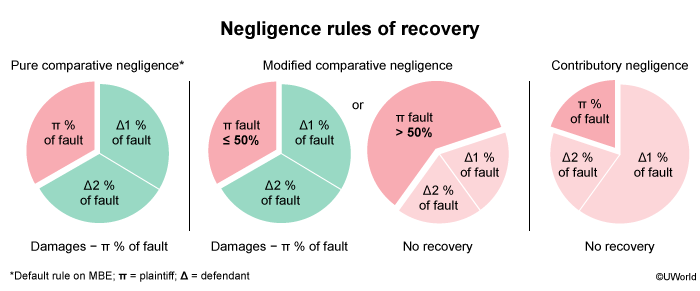A woman who was driving down a busy street was lost, but she did not want to stop to figure out where she was going. Instead, she used her knees to control the steering wheel while she pulled up a map on her smartphone. As the woman approached an intersection, a truck driver coming from the opposite direction tried to make an illegal U-turn in front of her car. The woman looked up from her smartphone and immediately tried to grasp her steering wheel, but she was unable to swerve out of the way in time, so the truck crashed into her car.
The woman filed a negligence action against the truck driver to recover $100,000 in damages for injuries sustained in the accident. At trial, the trier of fact established that the woman and the truck driver were equally at fault.
Which of the following is an accurate statement of the damages that the woman can recover?
A) In a contributory negligence jurisdiction, the woman can recover $50,000. [10%]
B) In a modified comparative-negligence jurisdiction, the woman can recover $50,000. [48%]
C) In a modified comparative-negligence jurisdiction, the woman can recover nothing. [36%]
D) In a pure comparative-negligence jurisdiction, the woman can recover nothing. [6%]
Note: The percentage next to the answer indicates what percent of UWorld users selected that answer option.
Explanation
In traditional contributory-negligence jurisdictions, a plaintiff who fails to use reasonable care for his/her own safety and thereby contributes to his/her own injury is barred from recovering damages. However, almost all jurisdictions have adopted some form of comparative fault (ie, comparative negligence). There are two forms of comparative fault:
- Pure comparative fault (default rule on the MBE) – recovery is reduced by the plaintiff's percentage of fault
- Modified comparative fault – the same as pure comparative fault, except that recovery is barred if the plaintiff's fault exceeds 50%*
Here, the woman sought to recover $100,000 in damages from the truck driver. The trier of factA judge (in a bench trial) or jury (in a jury trial) that determines fact issues at trial. established that the woman and the truck driver were equally at fault for the accident.
- In a contributory negligence jurisdiction, the woman's fault would preclude her from recovering any damages (Choice A).
- In a pure comparative-fault jurisdiction, the woman's full damages would be calculated by the trier of fact and then reduced by the proportion that the plaintiff's fault bears to the total harm ($100,000 - $50,000 = $50,000) (Choice D).
- In a modified comparative-fault jurisdiction, the woman can recover because her fault did not exceed 50% (Choice C).* However, her total damages will be reduced by her percentage of fault ($100,000 - $50,000 = $50,000).
Therefore, the most accurate statement of damages is that the woman can recover $50,000 in a modified comparative-fault jurisdiction.
*This is the view in the vast majority of modified comparative-fault jurisdictions. However, in a small minority of these jurisdictions, a plaintiff recovers nothing when the plaintiff and defendant are equally at fault.
Educational objective:
In a pure comparative-fault jurisdiction, recovery is reduced by the plaintiff’s percentage of fault. The same is true for a modified comparative-fault jurisdiction, except that recovery is barred if the plaintiff’s fault exceeds 50%.
References:
- 57B Am. Jur. 2d Negligence § 954 (2020) (comparative negligence, generally).
